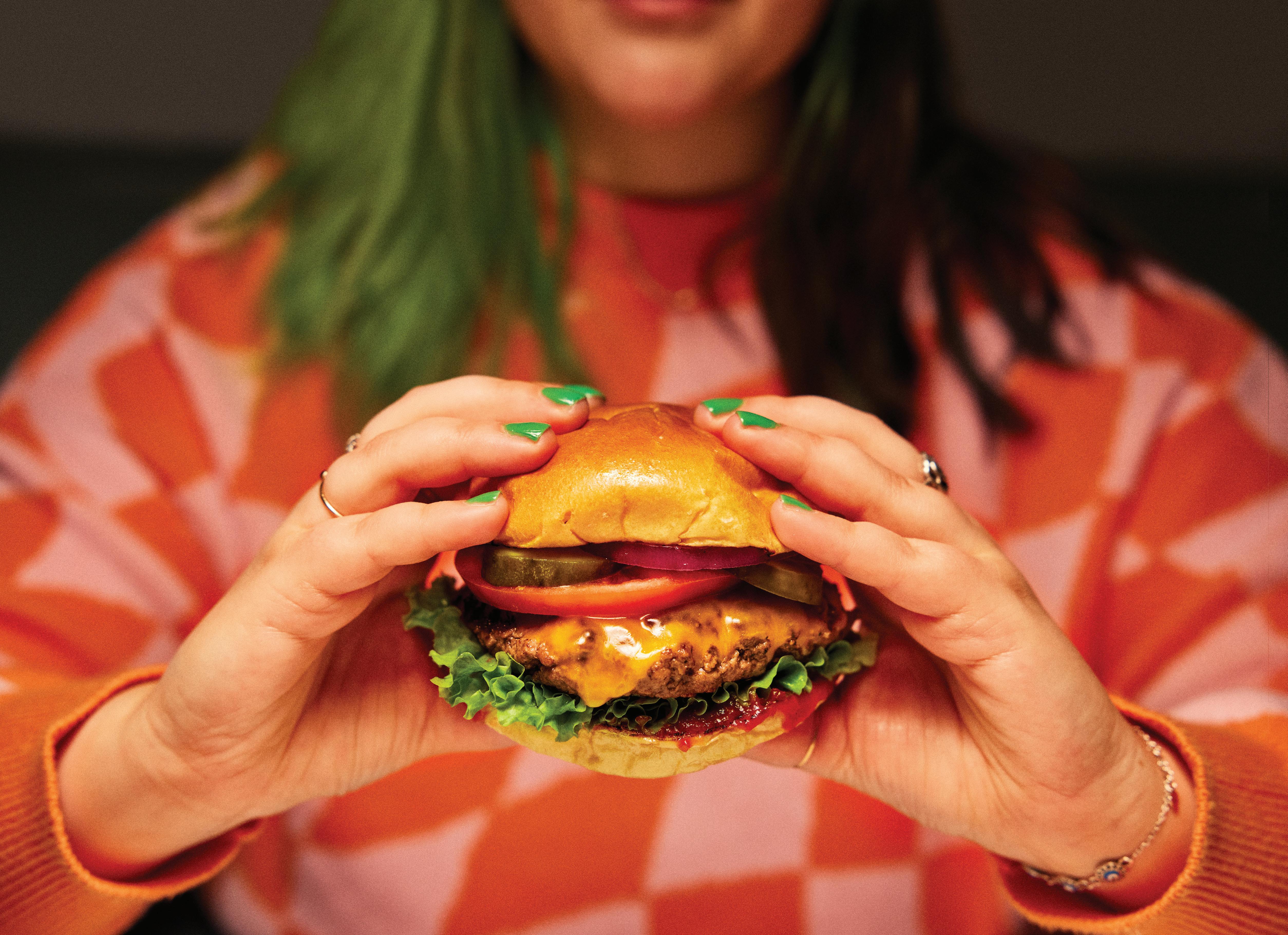The University of Maryland’s Independent Student Newspaper
THE DIAMONDBACK
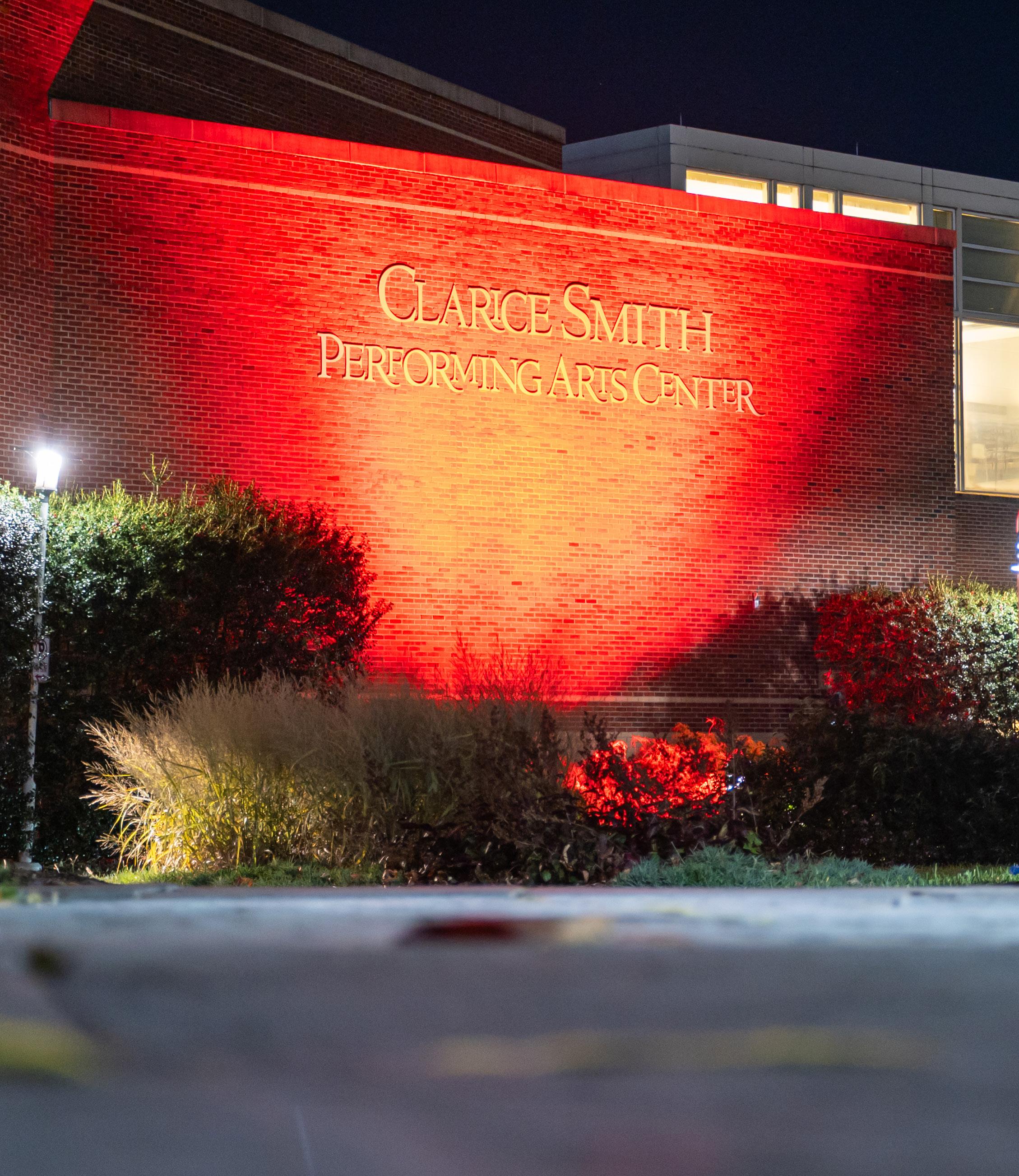
Arts & life guide
Founded 1910, independent since 1971.
LIZZY ALSPACH
Editor-in-Chief
3150 S. Campus Dining Hall, College Park, Md., 20742 (301) 314-8200 https://dbknews.com/contact-us/
FULLY UPDATED AND EDITED BY:
Stella Garner
ADVERTISING: ads@dbknews.com (301) 276-5770
ORIGINAL TEXT BY:
Kya Amadi
Gabrielle Barke
Justin Mehlbrech
Amelia Tyman
COPY EDITED BY:
Lizzy Alspach
Olivia Borgula
Randy Chow
Natalie Jakubiak
Joe Wicke THE DIAMONDBACK: Job openings: https://dbknews.com/jobs/ Newsletter: https://ter.ps/DBKNL
Oliver Mack
Alexa Taylor
DESIGNED BY:
Rebecca Safra
Oliver Mack FRONT COVER PHOTO BY: Gurnoor Sodhi
FIND US ON






‘She Loves Me’ musical brings romcom shenanigans to The Clarice
By Gabrielle Barke | Diversionsreporter
The Clarice Smith Performing Arts Center’s Kay Theatre was packed Oct. 18 for the opening night of the musical She Loves Me.
Performed and produced by the University of Maryland’s theatre, dance and performance studies school, the musical primarily follows the story of two employees of Maraczek’s Parfümeria, Amalia Balash and Georg Nowack. The coworkers are bickering rivals who have been unknowingly sending love letters to each other through a “Lonely Hearts” column. Antics ensue when Mr. Nowack discovers the identity of his anonymous friend and realizes it is his displeasing coworker.
But Mr. Nowack and Ms. Balash are not always the center of attention — this ensemble musical features a heartwarming cast of characters, each with their own hopes, dreams and solo numbers. Supporting the production was a featured pit orchestra of musicians from this university’s music school, as well as projected closed captions.
“Ever since last year, I was trying to go to more Clarice events in general … This is one of the ones that seemed interesting,” said junior immersive
media design and studio art major Anna Marchler.
The musical began at the detailed storefront of “Maraczek’s Parfümeria,” the Bath and Bodyworks-esque shop that employs our main characters: Mr. Maraczek, Amalia Balash, Steven Kodaly, Arpad Laszlo, Georg Nowack, Ilona Ritter and Ladislav Sipos. As the characters entered their workplace, the front door of Maraczek’s lifted into the rafters to reveal an intricately designed parfumerie complete with stocked shelves of products and even a spiral staircase.
“I got to see how things came in and out when we had to do touch-ups and things, which is a lot of fun,” said sophomore theatre major Mary McHale, who helped paint the musical’s set.
She Loves Me contained both comedic and sincere beats that prompted a wide variety of emotions in the audience.
The eager character of Arpad, played by junior elementary education and theatre major Matthew Dietrich, created many of the show’s humorous moments. When attempting to convince Mr. Ma-
raczek to hire him as a salesperson, Arpad sincerely sang, “Why break someone in / When I’m already broken?”, prompting laughter from the audience.
The musical featured many emotional twists and turns. The audience voiced “ooohs” of surprise when Mr. Maraczek learned that his employee, Mr. Kodaly, was having an affair with his wife. When Maraczek’s subsequent exit from the stage was followed by the ring of a gunshot, the audience gasped in shock, and a hush fell over the theater. Don’t worry — Maraczek reappeared safe in a hospital bed at the beginning of Act 2, resolving the tension from his previous scene.
Throughout the show, the central enemies-to-lovers romance between Amalia and Georg had viewers on the edge of their seats. When the building drama finally resulted in the two lovebirds kissing under falling snow, loud cheering rang out from the crowd.
“I felt like that was the most heartfelt rom-com I’ve seen in a while,” said sophomore theatre major Dean White after the show.
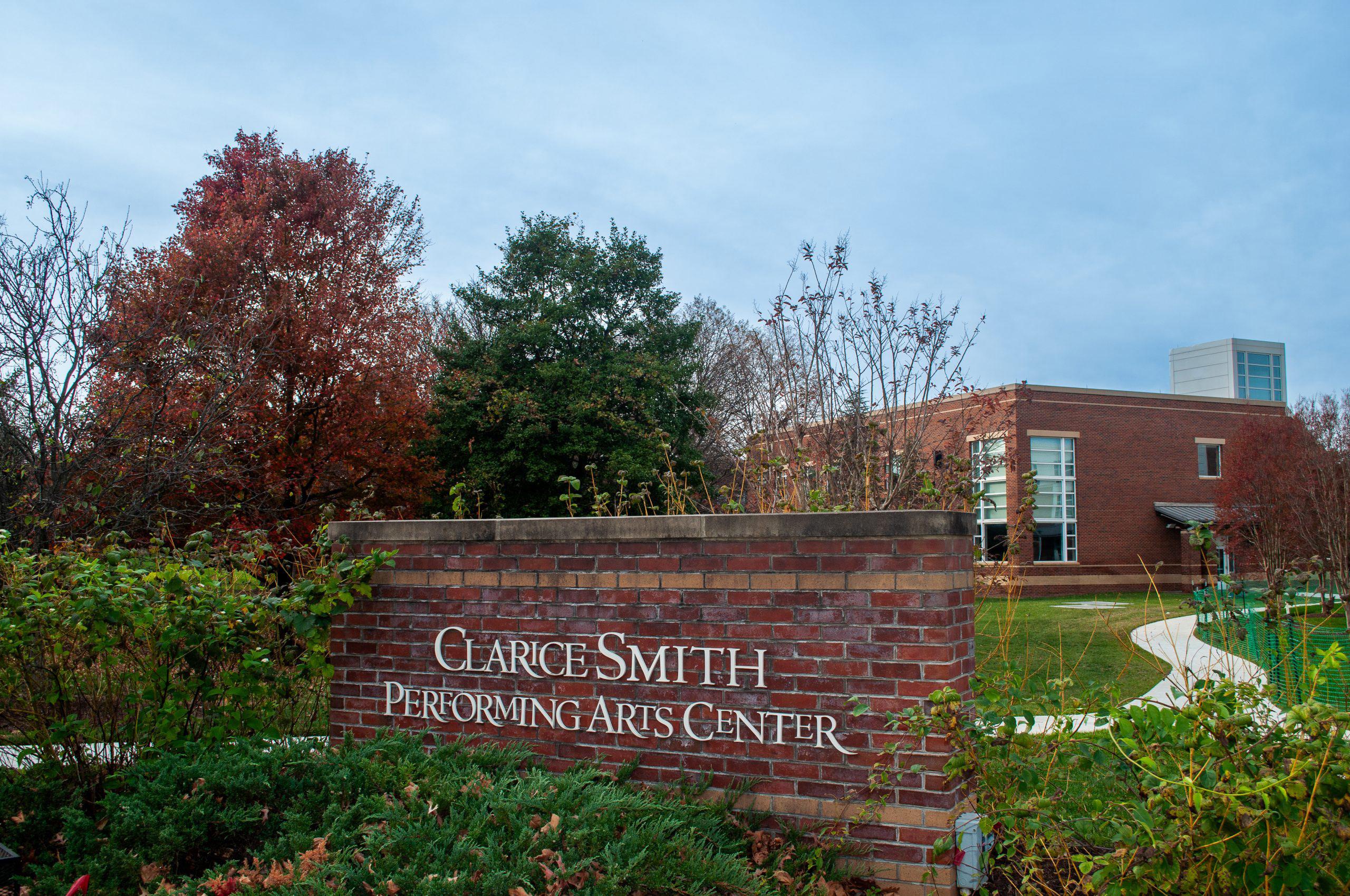
Sophomore finance and theatre major Jordan Richard described the experience on stage as a “lovely adrenaline rush.”
Richard played a humorous waiter and a customer on opening night, but he also holds roles as Kodaly’s understudy and the show’s dance captain.
“Half of the people in that performance are non-theatre majors,” he said. “It is truly such a lovely melting pot of people that you get to know, and I think that that’s what makes theater great — it’s pulling experiences from your own life and different people you meet.”
Nyumburu’s Juke Joint open mic celebrates community pride through the arts
By Joe Wicke I Diversions editor
The rattling snares of a drum kit brought the 2025 Homecoming Juke Joint to a start in Stamp Student Union on Oct. 29.
The Nyumburu Jazz Club gradually crept into Juan Tizol and Duke Ellington’s “Caravan.” Cymbals snaked in and bass guitar punctuated the pauses. With a baritone saxophone, trumpet and piano, the band fully assembled with exotica flair.
The jazz club began a night of music, dance and poetry, exalting various cultures and fostering community.
Hosted by the Nyumburu Cultural Center, Juke Joint is a monthly open mic event for students and community members to showcase their multidisciplinary talents. While a typical session lasts about 90 minutes, the October session spanned three hours to celebrate the University of Maryland’s homecoming week.
Jason Christopher, a junior information systems major, said the homecoming event was his third time at Juke Joint. He finds the event to be a reminder of the community this university offers outside of academics.
“It’s a place where a lot of people who [have] similar backgrounds get to express themselves, whether it be poetry, dance or song,” Christopher said. “Seeing that expressed onstage is beautiful, and it kind of brings people together.”
Junior information science and information systems major, Dorian Mkam similarly said Juke Joint offers a respite from classwork.
“UMD is an academic-heavy school, but us being able to showcase what we can do outside of school is always cool,” Mkam said.
Various dance groups took the stage throughout the night.
Decked out in camouflage pants, allwomen African dance group Afrochique performed its boot camp-inspired routine, claiming only the top cadet dancers would be able to survive.
The group launched into precise, energetic movements to deliver this promise. With each meticulously choreographed step, the dancers moved together. Parts of the audience stood up to watch and even used chairs as vantage points.
Afrochique closed out Juke Joint more than three hours into the night and 30 minutes past its scheduled end. The crowd still came alive.
Natalie Gilmore, a freshman biological sciences major, said one of her favorite parts of the night was the audience’s infectious energy, as they would often break out into dance parties in between acts.
“I didn’t expect to get so hype out of nowhere,” Gilmore said. “I thought it was really cool.”
Diazporic, a co-ed African dance team at this university, featured similar maximalist movements as zombified Eagle Scouts to celebrate Halloween. UMD S.T.E.P.P., a step dance team, paid homage to slasher films and horror icons Ghostface and Jason Voorhees during its set.
“I’m African, so seeing African dance onstage and people celebrate that is something beautiful to see,” Christopher said.
Juke Joint did not limit itself to dance acts. Chavannah Green, a freshman business administration and management major, brought a violin onstage. Green’s act began serenely, as intimate strings filled the space.
Suddenly, Green launched into Jeremih’s “Birthday Sex.” The crowd erupted.
Gerald Tabe, a sophomore neuroscience major and a Juke Joint regular, sang his act entirely in French. A blend of pop and R&B, he defined his vocals with an impossibly high falsetto.
Mkam said Tabe’s vocals were particularly impressive.
“The high notes that he was able to hit and the performance he was able to give to the crowd was honestly outstanding,” Mkam said. “He deserves a lot of praise for that performance, and I’d love to see him continue singing.”
Spoken-word artist and senior public health science major Mohammed Salih recited a poem about the Trump administration’s efforts to intimidate people of color, rebutting that communities carry more power than the administration realizes.
“We shouldn’t live in fear, we’ve got nothing to be afraid of, we’ve got our community,” Salih reminded the audience before the set.
It’s this community, Gilmore said, that gives her a deep sense of pride. “I was sitting down the whole time thinking, ‘Oh my gosh, I love being Black,’ because it was just fun,” Gilmore said. “It gives you a sense of pride, you know what I’m saying?”
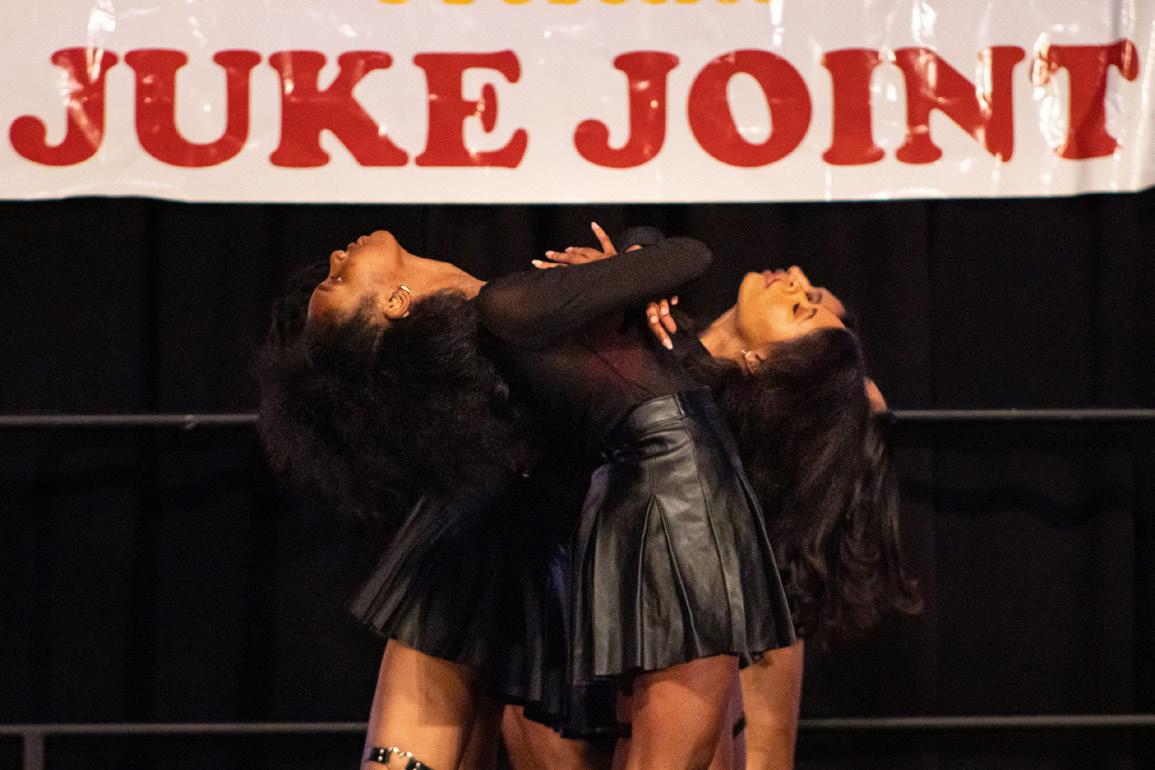
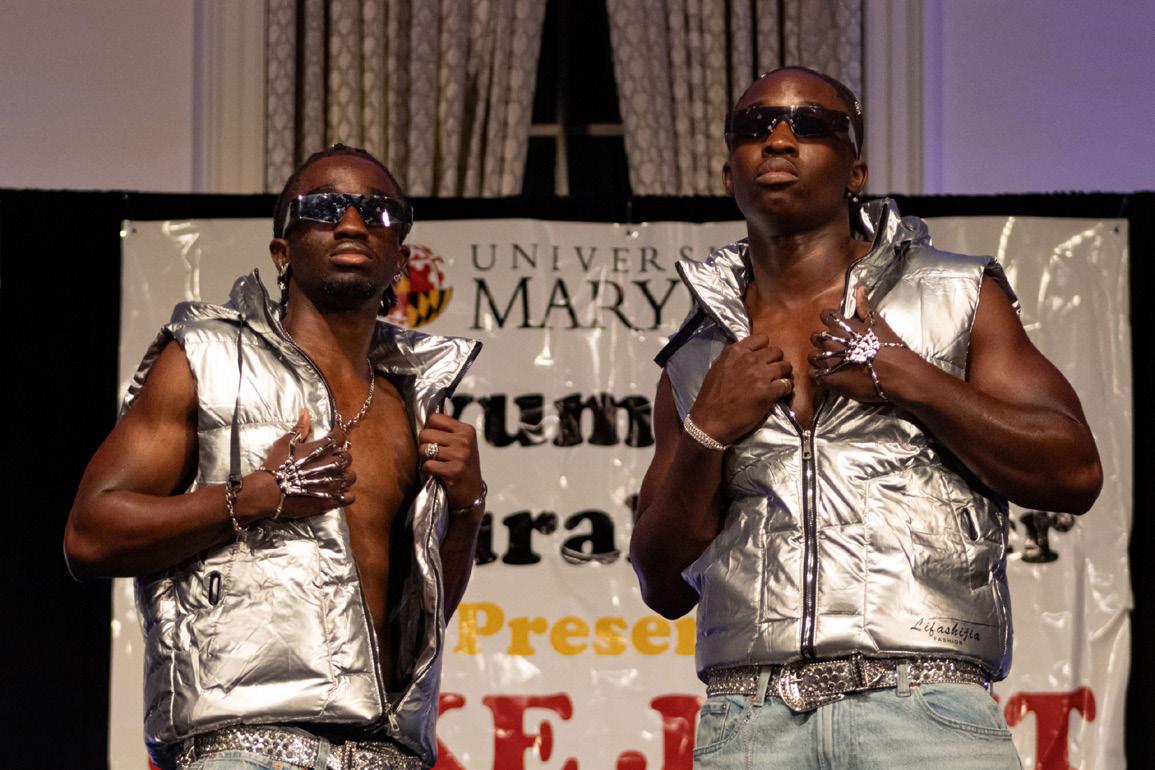
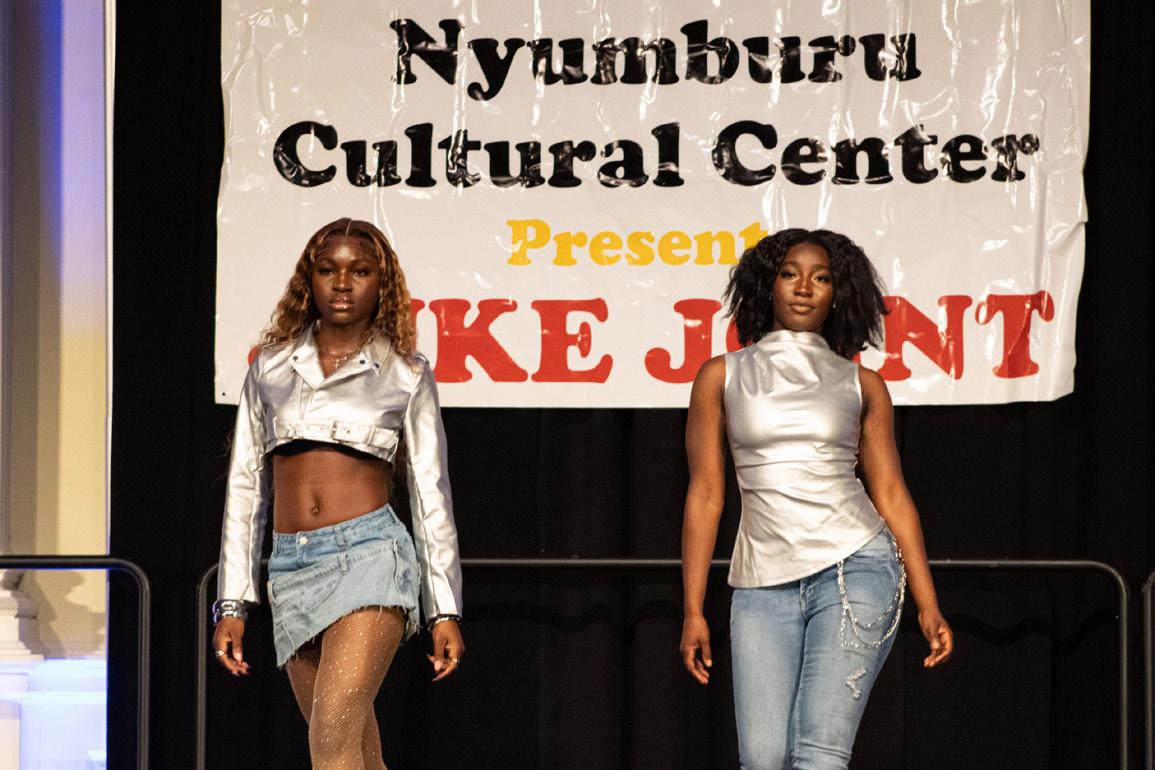
New Hornbake Library exhibit honors Sesame Street’s cultural pioneering
Hornbake Library unveiled its exhibit, “The UMD Sesame Street Archival Showcase,” on Oct. 1, which explores the educational experience and cultural impact of the beloved puppet show Sesame Street. A quaint corner of archives, featuring documents, puppets and photographs, celebrates the groundbreaking phenomenon of Sesame Street, exploring its humor and nostalgia just as much as its impact.
Susie Tofte, an archivist at The Jim Henson Company, captures Jim Henson’s legacy and presence at the University of Maryland, more than 60 years after his graduation. At the opening ceremony, Tofte gave a speech about Henson’s life and artistry. Tofte expressed her fondness for Henson’s dedication to his craft and the timelessness of his characters. From performing on television to pitching The Muppet Show for years until it aired in 1976, Tofte reflected on Henson’s tenacity in making his goals a reality.
“He was not afraid to try new things,” Tofte said. “That’s a really great quality to have in life.”
Paul Cote, a senior lecturer in the English department, attended the exhibit’s premiere. He is teaching a course this semester titled “The Henson Family as Filmmakers,” which focuses on Henson’s work beyond Sesame Street and his family’s careers in the
By Kya Amadi and Justin Mehlbrech | Diversionsreporters
filmmaking industry.
Heather Henson, Jim Henson’s daughter, founded Handmade Puppet Dreams, a company that showcases new puppeteers who bring their creations to life through film. Through her collaboration with the Green Feather Foundation, Henson assists in production efforts for independent puppeteers to create work for the screen.
Cote regards Henson’s work as a callback to her father’s artistic activism, being “outside of what commerciality is supposed to look like.”
Chad Infante, an assistant professor in the English department, helped organize the exhibit. He said part of his work at this university is to spotlight the work of notable alumni such as Henson, Aaron McGruder and Jeff Kinney.
“The real goal of this exhibit was to inspire students to think about their time here as students on UMD’s campus, by highlighting both the materials that we have that they could access, but also the legacies of former students,” Infante said.
The showcase highlighted screenings of Sesame Street in Jamaica during the 1970s, an effort to introduce children in rural areas to television and determine if the show’s stories could connect across cultures. A blend of photographs and documents, the display
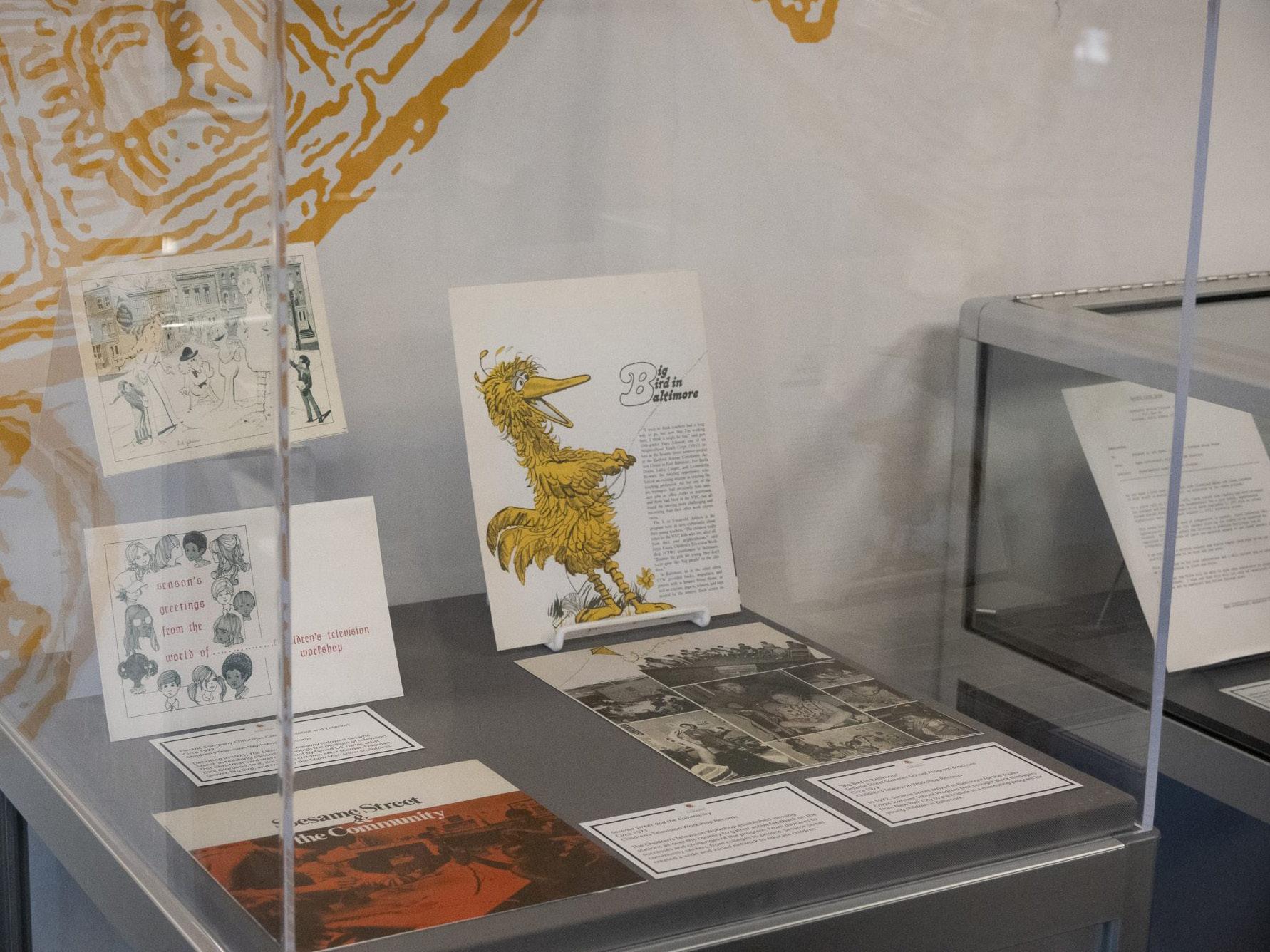
celebrates Sesame Street’s unquestionable international impact and cultural reach.
Originally from Jamaica, Infante found the archives on the project particularly intriguing.
“It really allowed me to catch a glimpse of the people I care about in the work,” Infante said.
Efforts continue to bring Sesame Street to Jamaican children. The Sesame Workshop is currently partnering with various organizations to bring the educational television episodes to communities across the country.
Infante thinks Sesame Street also aims to make its educational content personal.
“They draw on specific cultural traditions of the place they’re in,” Infante said.
Alex Buckton, a library and information science graduate student aspiring to work in archives and special collections, remarked how cool it was to see Roosevelt Franklin, the first Black Muppet, at the event.
Roosevelt Franklin’s character was controversial, loved by some and criticized by others. Sesame Street actor Matt Robinson, his creator and original voice actor, saw the puppet as a way for the show to reach Black children.
“Somewhere around four or five, a Black kid is going to learn he’s Black,” Robinson said in a 1971 interview. “He’s going to learn that’s positive or negative. What I want to project is a positive image.”
Roosevelt Franklin’s presence in the show was highly debated — many thought his character was stereotypical and one-dimensional. The puppet ultimately made his last appearance in 1977. But for those who are interested, they can learn about his history in the exhibit.
“I feel like everyone would love to see Franklin,” Buckton said.
The planning of the event helped inspire Cote to create his course and take advantage of the already existing relationship between this university and Henson. He hopes to have multiple members of the Henson family speak to his class during the semester.
In speaking to some family members for course preparation this past summer, Cote found that “just meeting your heroes was really something special.”
“The UMD Sesame Street Archival Showcase” will remain open until Dec. 20. Archive images and drawings of the Sesame Street characters interacting with Baltimore or display at Hornbake Library on Oct. 1, 2025. (Ashley Neyra/ The Diamondback)
Students are nuts for UMD’s squirrel watching club
By Gabrielle Barke I Diversionsreporter
In March 2021, The Diamondback published an article on the status of the University of Maryland’s lettuce club. But then-reporter Dylan Shulman’s mission left him wondering about another organization.
“I wonder if the Squirrel Watching Club is active nowadays,” he wrote.
Fast forward to Oct. 21. This university’s Maryland Squirrel Watchers held a Halloween-themed meeting in the basement of Jiménez Hall, promising “a mysterious night of intrigue, betrayal, and old-fashioned family fun” for attendees.
As Squirrel Watchers filled the classroom, members brought out snacks, an acorn-shaped globe and the club’s mascot — a stuffed squirrel named Brrrrrick. The meeting began with humorous slides reviewing the history of the club and introducing the board.
But then the lights went out. When they came back on, the club’s president was lying “dead” on the ground.
The Diamondback spoke with the corpse in question, co-president of the Maryland Squirrel Watchers and junior computer science major Jonathan Jayaputra.
Jayaputra said he and his friends were inspired by Maryland Images tours to create the Maryland Squirrel Watchers.
“Every tour group, they say that there is a squirrel club on campus,” Jayaputra said. “When we were coming in,
three or four years ago now, we were hearing about the squirrel club.”
After looking for the club, Jayaputra realized it was nowhere to be found. That’s why in November 2024, he and his friends decided to make their own squirrel-watching organization.
As was evident at the spooky-themed meeting, the club’s initiatives go beyond admiring the campus’ squirrel population.
Jayaputra said because squirrels are the most common animal seen on campus, it is only fitting that the student body have a club dedicated to them.
This semester, the Maryland Squirrel Watchers worked on a “Data Harvesting Initiative.” Students submitted photos of campus squirrels to a shared Google Form for the chance to win a free T-shirt.
When the club received more than 130 submissions of squirrel photos, three lucky participants were chosen at random to receive a free shirt. And in September, the Squirrel Watchers partnered with the Terrapin Trails Club for a squirrel walk around Lake Artemesia.
But beyond that, the Maryland Squirrel Watchers is a social club.
“We really try to host events that people will enjoy,” junior computer engineering major Amanda Callaghan
said. “It’s just a good place to have fun, relax, joke about squirrels, things that are slightly less squirrel-themed, like murder mystery.”
At the Oct. 21 meeting, the squirrel watchers were split into groups of detectives and given different pieces of “evidence” to complete the murder mystery, with the game’s rules resembling a squirrel-themed version of Clue.
Callaghan, who serves as diversity, equity and inclusion chair and secretary, was later revealed to be Jayaputra’s murderer.
While the club members were busy uncovering a murder plot, the organization’s affinity for the campus squirrels remained apparent.
“I think they’re very cute and adorable,” said junior computer science major Jack Campbell after the meeting. “I’m glad there’s a club that supports them.”
In the future, the club hopes to continue hosting social events that encourage an appreciation for the University of Maryland’s squirrels.
“We have so many people here today. I mean, it’s just building our membership. Spreading the love of squirrels,” Jayaputra said.
So, to answer Shulman’s inquiry, yes. The Squirrel Watching Club is active nowadays.

UMD students celebrate diversity of South Asian culture at multicultural night
By Amelia Twyman | Staff writer
When the University of Maryland’s South Asian a capella group, Anokha, took the floor of Stamp Student Union’s Colony Ballroom on Thursday night, a hush fell over the crowd.
Students turned their attention to the group of performers dressed in colorful clothing, some wearing kurtas, salwar kameezes and lehengas. They began to fill the room with the sounds of their voices, which wove together in harmony.
Anokha’s performance was one of many elements that paid homage to South Asian culture on Multicultural Night, an annual event hosted by this university’s South Asian Student Association that typically draws about 200 people, according to Mahee Patel, the association’s co-president.
Patel said Multicultural Night aims to spotlight the practices and traditions of all eight countries in South Asia. Many people tend to associate the region with India, the largest and most populous country, but it also includes Afghanistan, Pakistan, Nepal, Bhutan, Bangladesh, Sri Lanka and Maldives, she said.
“Even though there’s a lot of similarities and people like to group South Asian countries together, there is a lot of diversity within just those eight countries,” the senior criminology and criminal justice major said.
The organization has hosted their Multicultural Night every fall for the past few years, but it changed things up this year by collaborating with this university’s Nepali and Indian student associations.
Senior information science major Arnav Patel, the South Asian Student Association’s other co-president, said the partnership aimed to branch out and incorporate more activities from different South Asian countries.
“It’s to connect people culturally on this campus and
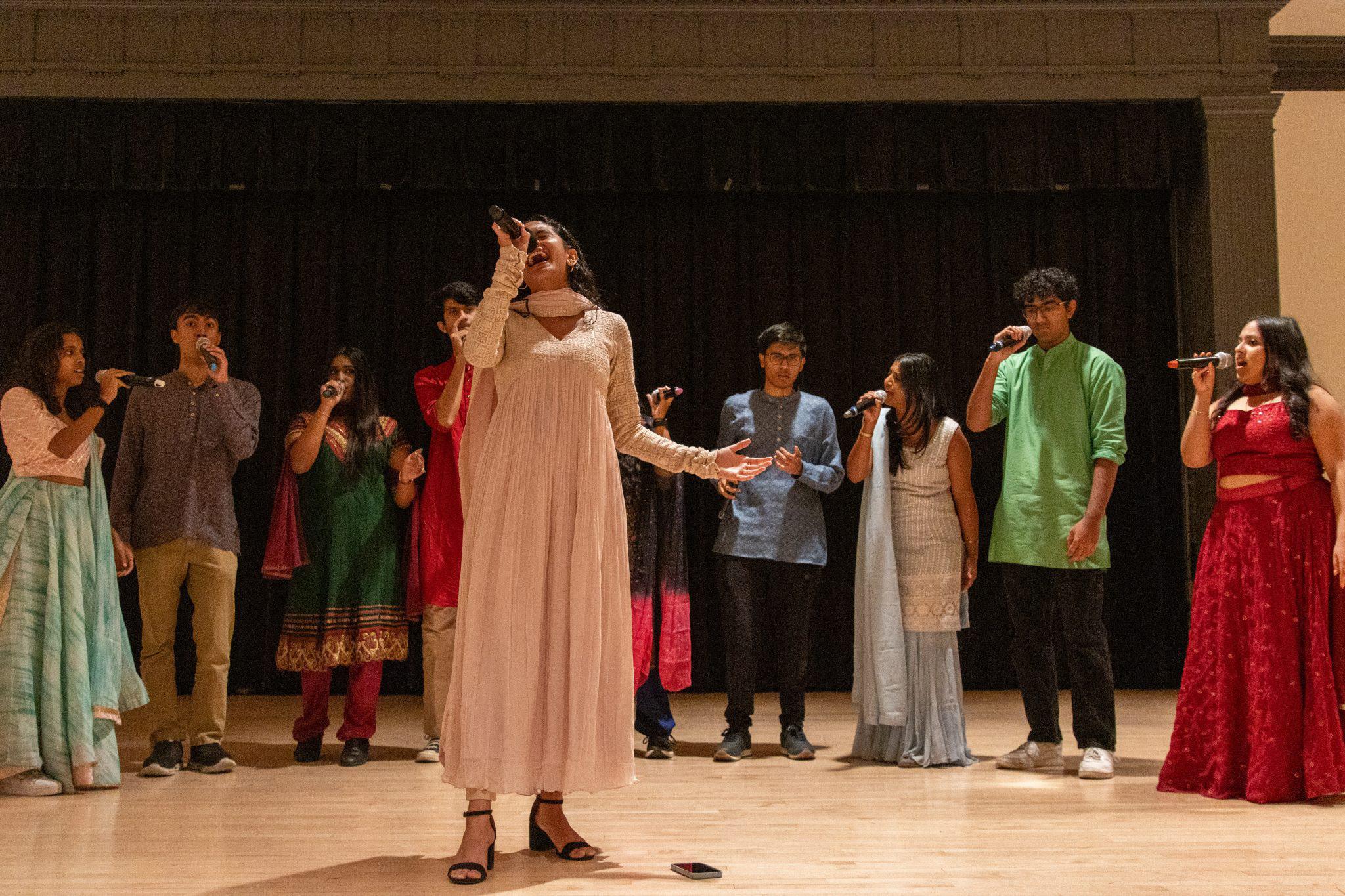
show them that there’s so much diversity here and around the globe,” he said.
Booths representing all eight South Asian countries were placed around the outskirts of Stamp’s Colony Ballroom on Thursday. Each one displayed a poster board with information about its associated country’s history, culture and geography.

Some tables served traditional cuisine, drawing long lines of students that only began to fade after the food ran out. Dishes included biryani, butter chicken, samosas, falooda and chatpate, a food often eaten in the streets of Nepal.
Chatpate is typically made with Wai Wai spice noodles, puffed rice, chaat masala seasoning and fresh vegetables such as tomatoes, cucumbers and onions, according to junior
biology and math major Sudha Poudel, who is the president of this university’s Nepali Student Association.
Poudel usually just throws the ingredients in a bag, shakes it up and eats it, she said.
Students also sipped on chai boba provided by Boba Chai Barista throughout the night. The recently opened Indian restaurant Maryland Tandoor helped sponsor Thursday’s event, along with Indian Kitchen.
Freshman physiology and neurobiology major Vedansh Sawhney said he sampled all of the food at Multicultural Night .
“It’s such a nice melting pot of a lot of different cultures,” he said.
In between bites of food, students stopped at stations to make bracelets, receive tarot card readings and get their hands intricately decorated with henna art. They chatted with new acquaintances and challenged friends to rounds of the popular Indian boardgame carrom, which was scattered throughout the ballroom on tabletops.
CORRECTION: A previous version of this story misstated that Anokha members wore saris in their a cappella performance. Some wore salwar kameezes and lehengas, not saris. A previous version of this story also misstated that chai boba was provided by Maryland Tandoor. It was provided by Boba Chai Barista. This story has been updated.

